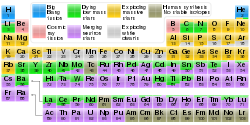Cosmic ray spallation Contents The process See also References Further reading External links Navigation menueRay Isotope SpectrometerUniversity of Leeds paperHeavy Cosmic Ray propagation Using New Spallation Cross-Section ExpressionsEvidence for cosmic ray spallation production of helium and neon found in volcanoes
Cosmic raysNucleosynthesis
nucleosynthesischemical elementscosmic raysparticlesEarthprotonsalpha particlesspallationmatternucleonslithiumberylliumboronnucleosynthesisBig Bang nucleosynthesisdeuteriumtritiumisotopesaluminiumcarboncarbon-14chlorineiodineneoncosmogenic nuclidescosmogenic radionuclide datingcosmic raynucleusatomrockssoilEarth'satmospheremeteoritesscientistsgeologicalastronomicalradioactivestabletritiumphosphorusprimordial nuclidesberyllium-7
| Nucleosynthesis |
|---|
 |
|
Related topics |
|
Cosmic ray spallation is a naturally occurring nuclear reaction causing nucleosynthesis. It refers to the formation of chemical elements from the impact of cosmic rays on an object. Cosmic rays are highly energetic charged particles from beyond Earth, ranging from protons, alpha particles, and nuclei of many heavier elements. About 1% of cosmic rays also consist of free electrons.
Cosmic rays cause spallation when a ray particle (e.g. a proton) impacts with matter, including other cosmic rays. The result of the collision is the expulsion of large numbers of nucleons (protons and neutrons) from the object hit. This process goes on not only in deep space, but in Earth's upper atmosphere and crustal surface (typically the upper ten meters) due to the ongoing impact of cosmic rays.
Contents
1 The process
2 See also
3 References
4 Further reading
5 External links
The process

A version of the periodic table indicating the origins – including cosmic ray spallation – of the elements. All elements above 103 (lawrencium) are also manmade and are not included.
Cosmic ray spallation is thought to be responsible for the abundance in the universe of some light elements such as lithium, beryllium, (Helium 3) and boron. This process (cosmogenic nucleosynthesis) was discovered somewhat by accident during the 1970s: models of Big Bang nucleosynthesis suggested that the amount of deuterium was too large to be consistent with the expansion rate of the universe and there was therefore great interest in processes that could generate deuterium after the Big Bang nucleosynthesis. Cosmic ray spallation was investigated as a possible process to generate deuterium. As it turned out, spallation could not generate much deuterium, however, the new studies of spallation showed that this process could generate lithium, beryllium and boron, and indeed these isotopes are over-represented in cosmic ray nuclei, as compared with solar atmospheres (whereas hydrogen and helium are present in about primordial ratios in cosmic rays).
In addition to the above light elements, tritium and isotopes of aluminium, carbon (carbon-14), chlorine, iodine and neon are formed within solar system materials through cosmic ray spallation, and are termed cosmogenic nuclides. Since they remain trapped in the atmosphere or rock in which they formed, some can be very useful in the dating of materials by cosmogenic radionuclide dating, particularly in the geological field. In formation of a cosmogenic nuclide, a cosmic ray interacts with the nucleus of an in situ solar system atom, causing cosmic ray spallation. These isotopes are produced within earth materials such as rocks or soil, in Earth's atmosphere, and in extraterrestrial items such as meteorites. By measuring cosmogenic isotopes, scientists are able to gain insight into a range of geological and astronomical processes. There are both radioactive and stable cosmogenic isotopes. Some of the well-known naturally-occurring radioisotopes are tritium, carbon-14 and phosphorus-32.
The timing of their formation determines which nuclides formed by cosmic ray spallation are termed primordial and which are termed cosmogenic (a nuclide cannot belong to both classes). Certain stable nuclides of lithium, beryllium, and boron found on Earth are thought to have been produced by cosmic ray spallation predominantly before the solar system's formation (thus making these primordial nuclides, by definition) are not termed "cosmogenic," even though they were formed by the same process as the cosmogenic nuclides (although at an earlier time). In contrast, the radioactive nuclide beryllium-7 falls into this light element range, but this nuclide has a half-life too short for it to have been formed before the formation of the solar system, so that it cannot be a primordial nuclide. Since the cosmic ray spallation route is the most likely source of beryllium-7 in the environment, it is therefore cosmogenic.
See also
- Cosmic rays
- Nuclear fission
- Nucleosynthesis
- Astrophysics
Spall, or spalling- Spallation
- Spallation Neutron Source
- ISIS neutron source
- PSI Spallation Neutron Source (SINQ)
References
This article includes a list of references, related reading or external links, but its sources remain unclear because it lacks inline citations. (April 2009) (Learn how and when to remove this template message) |
Further reading
- M. Meneguzzi, J. Audouze, H. Reeves, « The production of the elements Li, Be, B by galactic cosmic rays in space and its relation with stellar observations », Astronomy and Astrophysics, vol. 15, 1971, p. 337-359
External links
Ray Isotope Spectrometer[permanent dead link]
University of Leeds paper[permanent dead link], proceedings of the 26th ICRC.(Link down, Jan 2011)
Heavy Cosmic Ray propagation Using New Spallation Cross-Section Expressions[permanent dead link], proceedings of the 26th ICRC.(Link down, Jan 2011)- Evidence for cosmic ray spallation production of helium and neon found in volcanoes
